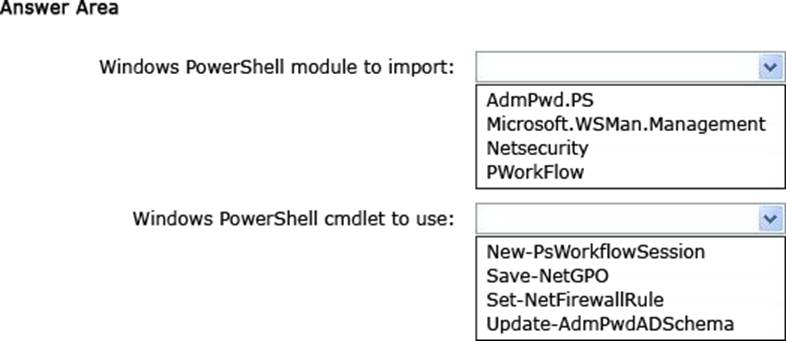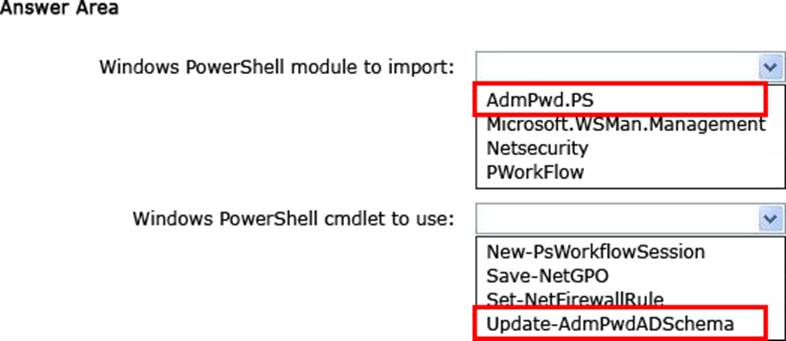Microsoft 70-744 Securing Windows Server 2016 Online Training
Microsoft 70-744 Online Training
The questions for 70-744 were last updated at Dec 28,2025.
- Exam Code: 70-744
- Exam Name: Securing Windows Server 2016
- Certification Provider: Microsoft
- Latest update: Dec 28,2025
Note: This question is part of a series of questions that use the same or similar answer choices. An answer choice may be correct for more than one question in the series. Each question is independent of the other questions in this series. Information and details provided in a question apply only to that question.
Your network contains an Active Directory domain named contoso.com. The domain contains a server named Server1 that runs Windows Server 2016 and a Nano Server named Nano1.
Nano1 has two volumes named C and D.
You are signed in to Server1.
You need to configure Data Deduplication on Nano1.
Which tool should you use?
- A . File Explorer
- B . Shared Folders
- C . Server Manager
- D . Disk Management
- E . Storage Explorer
- F . Computer Management
- G . System Configuration H. File Server Resource Manager (FSRM)
Note: This question is part of a series of questions that use the same or similar answer choices. An answer choice may be correct for more than one question in the series. Each question is independent of the other questions in this series. Information and details provided in a question apply only to that question.
Your network contains an Active Directory domain named contoso.com. The domain contains a file server named Server1 that runs Windows Server 2016.
You need to create Work Folders on Server1.
Which tool should you use?
- A . File Explorer
- B . Shared Folders
- C . Server Manager
- D . Disk Management
- E . Storage Explorer
- F . Computer Management
- G . System Configuration
- H . File Server Resource Manager (FSRM)
Note: This question is part of a series of questions that use the same or similar answer choices. An answer choice may be correct for more than one question in the series. Each question is independent of the other questions in this series. Information and details provided in a question apply only to that question.
Your network contains an Active Directory domain named contoso.com. The domain contains a server named Server1 that runs Windows Server 2016.
Server1 has a volume named Volume1.
Dynamic Access Control is configured. A resource property named Property1 was created in the domain.
You need to ensure that Property1 is set to a value of Big for all of the files in Volume1 that are larger than 10 MB.
Which tool should you use?
- A . File Explorer
- B . Shared Folders
- C . Server Manager
- D . Disk Management
- E . Storage Explorer
- F . Computer Management
- G . System Configuration
- H . File Server Resource Manager (FSRM)
Note: This question is part of a series of questions that use the same scenario. For your convenience, the scenario is repeated in each question. Each question presents a different goal and answer choices, but the text of the scenario is exactly the same in each question in this series.
Your network contains an Active Directory domain named contoso.com. The functional level of the forest and the domain is Windows Server 2008 R2.
The domain contains the servers configured as shown in the following table.

All servers run Windows Server 2016. All client computers run Windows 10.
You have an organizational unit (OU) named Marketing that contains the computers in the marketing department. You have an OU named Finance that contains the computers in the finance department. You have an OU named AppServers that contains application servers. A Group Policy object (GPO) named GP1 is linked to the Marketing OU. A GPO named GP2 is linked to the AppServers OU. You install Windows Defender on Nano1. You need to execute D:Folder1 on Nano1 from being scanned by Windows Defender.
Which cmdlet should you run?
- A . Set-StorageSetting
- B . Set-FsrmFileScreenException
- C . Set-MpPreference
- D . Set-DtcAdvancedSetting
HOTSPOT
Note: This question is part of a series of questions that use the same scenario. For your convenience, the scenario is repeated in each question. Each question presents a different goal and answer choices, but the text of the scenario is exactly the same in each question in this series.
Your network contains an Active Directory domain named contoso.com. The functional level of the forest and the domain is Windows Server 2008 R2.
The domain contains the servers configured as shown in the following table.

All servers run Windows Server 2016. All client computers run Windows 10.
You have an organizational unit (OU) named Marketing that contains the computers in the marketing department. You have an OU named Finance that contains the computers in the finance department. You have an OU named AppServers that contains application servers. A Group Policy object (GPO) named GP1 is linked to the Marketing OU. A GPO named GP2 is linked to the AppServers OU.
You install Windows Defender on Nano1.
You need to ensure that you can implement the Local Administrator Password Solution (LAPS) for the finance department computers.
What should you do in the contoso.com forest? To answer, select the appropriate options in the answer area.

Note: This question is part of a series of questions that use the same scenario. For your convenience, the scenario is repeated in each question. Each question presents a different goal and answer choices, but the text of the scenario is exactly the same in each question in this series.
Your network contains an Active Directory domain named contoso.com. The functional level of the forest and the domain is Windows Server 2008 R2.
The domain contains the servers configured as shown in the following table.

All servers run Windows Server 2016. All client computers run Windows 10.
You have an organizational unit (OU) named Marketing that contains the computers in the marketing department. You have an OU named Finance that contains the computers in the finance department. You have an OU named AppServers that contains application servers. A Group Policy object (GPO) named GP1 is linked to the Marketing OU. A GPO named GP2 is linked to the AppServers OU.
You install Windows Defender on Nano1. You need to ensure that the marketing department computers validate DNS responses from adatum.com.
Which setting should you configure in the Computer Configuration node of GP1?
- A . TCPIP Settings from Administrative Templates
- B . Connection Security Rule from Windows Settings
- C . DNS Client from Administrative Templates
- D . Name Resolution Policy from Windows Settings
Note: This question is part of a series of questions that use the same scenario. For your convenience, the scenario is repeated in each question. Each question presents a different goal and answer choices, but the text of the scenario is exactly the same in each question in this series.
Your network contains an Active Directory domain named contoso.com. The functional level of the forest and the domain is Windows Server 2008 R2.
The domain contains the servers configured as shown in the following table.

All servers run Windows Server 2016. All client computers run Windows 10.
You have an organizational unit (OU) named Marketing that contains the computers in the marketing department. You have an OU named Finance that contains the computers in the finance department. You have an OU named AppServers that contains application servers. A Group Policy object (GPO) named GP1 is linked to the Marketing OU. A GPO named GP2 is linked to the AppServers OU.
You install Windows Defender on Nano1.
You need to ensure that you can deploy a shielded virtual machine to Server4.
Which server role should you deploy?
- A . Hyper-V
- B . Device Health Attestation
- C . Network Controller
- D . Host Guardian Service
Note: This question is part of a series of questions that use the same scenario. For your convenience, the scenario is repeated in each question. Each question presents a different goal and answer choices, but the text of the scenario is exactly the same in each question in this series.
Your network contains an Active Directory domain named contoso.com. The functional level of the forest and the domain is Windows Server 2008 R2.
The domain contains the servers configured as shown in the following table.

All servers run Windows Server 2016. All client computers run Windows 10.
You have an organizational unit (OU) named Marketing that contains the computers in the marketing department. You have an OU named Finance that contains the computers in the finance department. You have an OU named AppServers that contains application servers. A Group Policy object (GPO) named GP1 is linked to the Marketing OU. A GPO named GP2 is linked to the AppServers OU.
You install Windows Defender on Nano1.
You need to disable SMB 1.0 on Server2.
What should you do?
- A . From File Server Resource Manager, create a classification rule.
- B . From the properties of each network adapter on Server2, modify the bindings.
- C . From Windows PowerShell, run the Set-SmbClientConfiguration cmdlet.
- D . From Server Manager, remove a Windows feature.
Note: This question is part of a series of questions that use the same scenario. For your convenience, the scenario is repeated in each question. Each question presents a different goal and answer choices, but the text of the scenario is exactly the same in each question in this series.
Your network contains an Active Directory domain named contoso.com. The functional level of the forest and the domain is Windows Server 2008 R2.
The domain contains the servers configured as shown in the following table.

All servers run Windows Server 2016. All client computers run Windows 10. You have an organizational unit (OU) named Marketing that contains the computers in the marketing department. You have an OU named Finance that contains the computers in the finance department. You
have an OU named AppServers that contains application servers. A Group Policy object (GPO) named GP1 is linked to the Marketing OU. A GPO named GP2 is linked to the AppServers OU. You install Windows Defender on Nano1. You plan to implement BitLocker Drive Encryption (BitLocker) on the operating system volumes of the
application servers. You need to ensure that the BitLocker recovery keys are stored in Active Directory.
Which Group Policy setting should you configure?
- A . System cryptography: Force strong key protection for user keys stored on the computer
- B . Store BitLocker recovery information in Active Directory Domain Services (Windows Server 2008 and Windows Vista)
- C . System cryptography: Use FIPS compliant algorithms for encryption, hashing, and signing.
- D . Choose how BitLocker-protected operating system drives can be recovered.
Your network contains an Active Directory domain named contoso.com. You are deploying Microsoft Advanced Threat Analytics (ATA). You create a user named User1. You need to configure the user account of User1 as a Honeytoken account.
Which information must you use to configure the Honeytoken account?
- A . The SAM account name of User1
- B . The Globally Unique Identifier (GUID) of User1
- C . the SID of User1
- D . the UPN of User1
Latest 70-744 Dumps Valid Version with 207 Q&As
Latest And Valid Q&A | Instant Download | Once Fail, Full Refund


